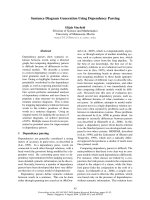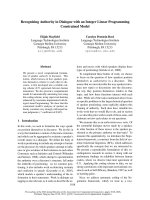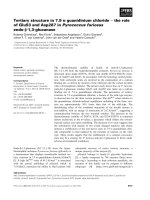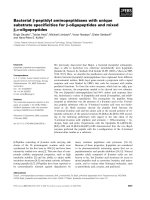Báo cáo khoa học: " Intensity-Modulated Radiotherapy in Patients with Cervical Cancer. An intra-individual Comparison of Prone and Supine Positioning" ppt
Bạn đang xem bản rút gọn của tài liệu. Xem và tải ngay bản đầy đủ của tài liệu tại đây (2.28 MB, 8 trang )
Stromberger et al. Radiation Oncology 2010, 5:63
/>Open Access
RESEARCH
© 2010 Stromberger et al; licensee BioMed Central Ltd. This is an Open Access article distributed under the terms of the Creative Com-
mons Attribution License ( which permits unrestricted use, distribution, and reproduc-
tion in any medium, provided the original work is properly cited.
Research
Intensity-Modulated Radiotherapy in Patients with
Cervical Cancer. An intra-individual Comparison of
Prone and Supine Positioning
Carmen Stromberger*
1
, Yves Kom
1
, Michael Kawgan-Kagan
1
, Tristan Mensing
1
, Ulrich Jahn
1
, Achim Schneider
2
,
Volker Budach
1
, Christhardt Köhler
2
and Simone Marnitz*
1
Abstract
Background: Chemoradiation for cervical cancer patients is associated with considerable gastrointestinal toxicity.
Intensity-modulated radiotherapy (IMRT) has demonstrated superiority in terms of target coverage and normal tissue
sparing in comparison to conventional 3D planning in gynaecological malignancies. Whether IMRT in prone (PP) or
supine position (SP) might be beneficial for cervical cancer patients remains partially unanswered.
Methods: 10 patients on FIGO stage IB-III cervical cancer, 6 patients for definitive and 4 patients for adjuvant external
beam pelvic RT, were planned in PP and SP using a 7-field IMRT technique. IMRT plans for PP and SP (mean dose, D
mean
50.4 Gy) were optimized in terms of PTV coverage (1
st
priority) and small bowel sparing (2
nd
priority). A comparison of
DVH parameters for PTV, small bowel, bladder, and rectum was performed.
Results: The comparison showed a similar PTV coverage of 95% of the prescribed dose and for target conformity in
IMRT plans (PP, SP). PTV, rectum and bladder volumes were comparable for PP and SP. Significantly larger volumes of
small bowel were found in PP (436 cc, + 35%, p = 0.01). PP decreased the volume of small bowel at 20-50.4 Gy (p < 0.05)
and increased the rectum volumes covered by doses from 10-40 Gy (p < 0.01), the V50.4 was < 5% in both treatment
positions. Bladder sparing was significant better at 50.4 Gy (p = 0.03) for PP.
Conclusion: In this dosimetric study, we demonstrated that pelvic IMRT in prone position for patients with cervical
cancer seems to be beneficial in reducing small bowel volume at doses ≥20 Gy while providing similar target coverage
and target conformity. The use of frequent image guidance with KV (kilovolt) or MV (megavolt) computertomography
can reduce set-up deviations, and treatment in prone position can be done with a higher set-up accuracy. Clinical
outcome studies are needed to affirm lower toxicity.
Background
Chemoradiation is the treatment of choice in locally
advanced, lymph node positive and/or high-risk cervical
cancer patients [1-9]. The treatment is associated with
considerable gastrointestinal, genitourinary, and haema-
tological toxicity [10,11]. Furthermore, the combination
of radical hysterectomy and adjuvant radiation leads to an
increase of therapy related toxicity [12,13]. In order to
cover tumour and locoregional lymph nodes adequately
with a 2-D or 3-D conformal radiotherapy technique,
large portions of small bowel must be included in the
radiation ports. The incidence and severity of gastroin-
testinal morbidity depends on the volume of small bowel
and on the radiation dose to the small bowel and corre-
lates with a pelvic surgery prior to radiotherapy [14-17].
In the past, efforts were made to reduce the incidence and
severity of gastrointestinal toxicity. Pelvic radiotherapy in
prone position on a belly-board device resulted in a sig-
nificant sparing of small bowel [18-23]. A recent study
showed that patient set-up in prone position is subject to
larger systematic errors, but the set-up in supine position
harbours larger random errors [24]. A superiority of
intensity-modulated radiotherapy (IMRT) over conven-
tional 3-D planning has been demonstrated for gynaeco-
* Correspondence: ,
Department of Radiooncology, Charité University Hospital, Campus CCM and
CVK, Augustenburger Platz 1, 13353 Berlin, Germany
Full list of author information is available at the end of the article
Stromberger et al. Radiation Oncology 2010, 5:63
/>Page 2 of 8
logical malignancies in terms of target coverage and
normal tissue sparing [25-29]. Furthermore, IMRT offers
the possibility of dose escalation without increased ther-
apy related toxicity [30,31]. Dose escalation with a simul-
taneous integrated boost is even feasible in patients with
advanced cervical cancer [32]. Even though oncological
results for IMRT seem to be similar to those for 3-D plan-
ning [33-35], issues concerning the optimal margins,
tumour regression, movement of organs at risk during the
course of radiotherapy and the optimal treatment posi-
tion remain a challenging field of research. In this study,
we assess whether a pelvic 7-field IMRT in prone or
supine position can be more efficient regarding the spar-
ing of small bowel, rectum and bladder in patients with
cervical cancer.
Methods
Patients
10 patients with histological confirmed cervical cancer
on FIGO stage IB1, IB2, IIB and IIIB were selected for this
study. 6 patients were treated with definitive chemoradia-
tion (FIGO stage: IB1 in 2 patients, IB2, IIA, IIB and IIIB
each in one patient). All of these patients underwent
transperitoneal laparoscopic pelvic and paraaortic
lymphadenectomy as described previously [36]. Pelvic
lymph node metastases were confirmed in all of these
patients. 4 patients (FIGO stage: IB1 in 3, and IIB in 1
patient) received an adjuvant chemoradiation. All
patients had an abdominal radical hysterectomy and a
pelvic lymphadenectomy. Prior to therapy, a chest X-ray
and abdominal ultrasound was performed to exclude dis-
tant metastases.
Imaging
For each patient, two consecutive treatment planning CT
scans (CT scanner LightSpeed
®
from GE Healthcare, Gen-
eral Electric Company, NYSE; GE), from the diaphragm
to the trochanter minor with a slice thickness of 3.75 mm.
were performed. The CT was performed with a belly
board in prone position (PP), and with a head rest, a knee
and ankle fixation in the supine position (SP). No instruc-
tions for bladder or rectum filling were given. The CT
scans were acquired during a period when both scans
were routinely carried out for patients with a high risk for
paraaortic metastases, in order to switch the treatment
technique easily if paraaortic metastases were histologi-
cally confirmed. Intravenous contrast mediaum (Xenetix
350
®
) and a vaginal tampon soaked in contrast medium
were used to aid the delineation; oral contrast media was
not used obligatorally.
Target volumes and organs at risk
According to the recommendations of the International
Commission on Radiation Units and Measurements
Reports (ICRU) 50 and 62, target volumes and organs at
risk were delineated in all axial CT slices [37,38]. For
definitive treatment, the gross tumour volume (GTV)
was defined as the macroscopic tumour, including the
cervix with visible tumour extension and the corpus uteri.
The clinical target volume (CTV) was defined by adding
5 mm to the GTV. Additionally, the external, internal and
common iliacs and the presacral lymph nodes were
included according to the RTOG recommendations [39].
For postoperative treatment, the CTV included all
regions of potential microscopic disease: the surgical bed,
regional lymph node areas (common, external and inter-
nal iliacs and the presacral region), and the vaginal cuff.
The planning target volume (PTV) was outlined as the
CTV plus 1 cm in all directions. The caudal field border
was at the obturator foramen, the upper field border was
individualized on the basis of the patient's anatomy to
include the common iliac lymph nodes [40]. The bladder,
the rectum (sigmoid to anus) and the small bowel (whole
peritoneal cavity without lymph nodes, muscles and
organs other than small bowel) were outlined as organs at
risk. The delineation of the small bowel exceeded the
upper and lower border of the PTV by 2 slices to generate
comparable volumes. All contours were done by one
investigator (C.S.) and review by the senior radiation
oncologist (S. M).
Dose Prescription and planning parameters
The Eclipse Planning Software (Version 7.3.10, Varian,
Palo Alto, CA) was used to generate IMRT plans for SP
and PP. The prescribed target dose was 5 × 1.8 Gy per
week, to a total mean dose of 50.4 Gy (D
mean
). Treatment
was performed on a linear accelerator (Clinac 2300CD,
Varian, Palo Alto, CA) with 20 MV photon beams. Plan-
ning parameters for the PTV were set to minimize the
amount receiving < 95% of the prescribed dose and the
amount receiving > 105% (52.9 Gy) of the prescribed
dose. The second highest priority was given to the spar-
ing of small bowel. Inverse planning input parameters are
shown in table 1. Constraints were applied as starting
parameters and changed individually for each patient
during optimisation. A help structure was generated by
applying a 2 cm ring around the PTV and was used for
normal tissue sparing adjacent to the PTV to achieve
higher dose conformity.
Radiation Technique
Treatment planning and the DVH analysis was done with
the Eclipse Planning Software (Varian Medical Systems,
Palo Alto, CA). IMRT plans were generated based on a
seven beam arrangement with beams at 45/90/115/180/
245/280/320 degrees for SP and 0/40/80/115/235/270/
320 degrees for PP, as is routinely applied at our clinic.
The sliding window technique was used. Although
patients also received brachytherapy, for this analysis,
only external beam irradiation has been taken into
account.
Stromberger et al. Radiation Oncology 2010, 5:63
/>Page 3 of 8
Dose Volume Histogram Analysis
DVH parameters for the target volume and critical nor-
mal tissues were analysed, and the PTV95% (volume of
PTV receiving 95% of the prescribed dose) and the D1%
(highest dose delivered to 1% of the PTV) was calculated.
The target conformity was calculated according to ICRU
reports 50 and 62 (Conformity Index, CI) [37,38] and
according to van't Riet and colleagues (Conformity num-
ber, CN) [41]. For all IMRT plans and patients set-up
positions, the relative volumes (%) of small bowel, rectum
and bladder were evaluated at 10 Gy (V10), 20 Gy (V20),
30 Gy (V30), 40 Gy (V40), 45 Gy (V45), and 50.4 Gy
(V50.4). The average volumes (cc) and the mean dose
(D
mean
) for the PTV and the organs at risk were mea-
sured. Dosimetric parameters were compared by the
non-parametric Wilcoxon exact signed rank test (SPSS
15.0, Inc., Chicago, IL). Statistical significance was
assumed for p ≤ 0.05.
Results
Target Volume
The mean volume of the PTV was 1227.0 cc (1110.8 -
1368.7 cc, standard deviation (STD) ± 66.6) for SP and
1369.4 cc (1085.4 - 1703.1 cc, STD ± 222.1) for PP (p =
0.6). D
mean
was 50.4 Gy in PP and SP, respectively. The
mean volume of PTV95% was 97.0% (STD ± 1.2) for SP
and 97.6% (STD ± 0.8) for PP. The mean D1% was 52.9 Gy
(STD ± 0.2) and 52.8 Gy (STD ± 0.2) for SP and PP,
respectively. The PTV that received 110% of the pre-
scribed dose was < 0.01% in both groups. Conformity of
IMRT plans for PP and SP IMRT gave similar results (CI:
1.13, STD ± 0.08 vs. 1.11, STD ± 0.06; CN: 0.85, STD ±
0.05 vs. 0.86, STD ± 0.05). All parameters did not reach
statistical significance.
Rectum
For the SP group, the delineated rectal volume ranged
from 48.3 to 94.2 cc (mean volume 71.2 cc, STD ± 18.2)
and for the PP group from 52.8 to 174.5 cc (mean volume
96.8 cc, STD ± 34.9; p = 0.08). In PP, a larger rectal vol-
ume was covered by the V10 to V40 (p ≤ 0.01, Figure 1).
Neither the V45 nor the V50.4 or D
mean
(SP: 39.4 Gy, STD
± 3.5; PP: 40.3 Gy, STD ± 12.5; p = 0.3) showed a statisti-
cally significant difference (Table 2).
Bladder
The bladder volume displayed a highly individual range
for both positions. In SP, the bladder volume ranged from
70.7 to 417.7 ml, with a mean value of 143.9 ml ± 98.3
(STD), and from 70.2 to 395.2 ml, with a mean of 137.0
ml ± 93.4 (STD) (p = 0.6) in PP. The dose-volume histo-
gram for the bladder was significant better in PP at V50.4
(p = 0.03). At V10, V20, V30, V40 and V45, no significant
differences were detected (Table 2). D
mean
for SP was 44.2
Gy ± 2.7 (STD) and 43.1 Gy ± 2.8 (STD) (p = 0.7) for PP.
Small Bowel
The small bowel volume varied from 683.8 to 1825.9 cc
(mean 1250.6 cc, STD ± 283.0) for SP and from 1193.4 to
2443.9 cc (mean 1686.1 cc, STD ± 368.7) for PP. Statisti-
cally significant larger volumes of small bowel were found
in PP (p = 0.01). Figure 2a. illustrates the expansion of the
peritoneal cavity through the belly board in PP resulting
in an anterior movement of the small bowel for these
patients. The analysis of the pooled dose-volume histo-
grams showed a significant decrease of the small bowel
volume at V20, V30, V40, V45 and V50.4 in favour of the
PP (p < 0.05, Table 2, Figure 3). D
mean
was 25.9 Gy vs. 30.2
Gy for PP and SP (p = 0.049), respectively.
Discussion
Due to an overlap of target structures (lymph nodes) and
organs at risk, there is a considerable rate of gastrointesti-
nal and genitourinary morbidity in patients with cervical
cancer undergoing pelvic irradiation [10]. With a plati-
num based chemoradiation, even a radiogenic total
Table 1: Planning parameters
Structure Volume (%) Gy Priority
Body 0 54 500-800
PTV 0 52.9 400
20 50.4 200
80 50.4 200
100 47.9 400
Help 049100
Small Bowel 0 50.4 100
10 43 150
20 33 150
Bladder 30 50 100
Rectum 25 50 100
Inverse planning starting parameters for PTV and for organs of
risk.
Stromberger et al. Radiation Oncology 2010, 5:63
/>Page 4 of 8
necrosis of the uterus is possible [42]. The risk of devel-
oping treatment related side effects depends strongly on
the delivered dose, the irradiated volume, and any previ-
ous pelvic or abdominal surgery [11-17,43]. In the prone
position, decreased dose to the small bowel was achieved
by using bowel displacement devices [18-23]. The use of
IMRT in clinical routine might decrease the risk for acute
and late toxicity in patients after pelvic or paraaortic irra-
diation with comparable outcome [28,29,33,34,44-47].
Although IMRT and treatment in prone position on a
belly board holds potential for decreased therapy related
gastrointestinal toxicity, the implication of the patient's
position when using IMRT has not been systematically
investigated. In the 2-D era, Letschert and colleagues [16]
Figure 1 DVH for Rectum. Mean DVH of the rectum in SP (pink) compared to PP (blue). Error bars indicate the standard deviation (STD).
Rectum
0
20
40
60
80
100
0 102030405060
Dose (Gy)
Volume (%)
PP
SP
Table 2: DVH statistics
Small bowel Rectum Bladder
PP SP PP SP PP SP
Volume (cc) 1686.1 ± 368.7* 1250.6 ± 283.0 96.8 ± 34.9 71.2 ± 18.2 137.0 ± 93.4 143.9 ± 98.3
D mean (Gy) 25.9 ± 3* 30.5 ± 4.5 40.3 ± 12.5 39.2 ± 3.5 43.1 ± 2.8 44.2 ± 2.7
V10 (%) 91.5 ± 4.7 92.0 ± 10.5 98.6 ± 2.1 88.5 ± 6.6 * 100.0 ± 0 99.9 ± 0.4
V20 (%) 60.4 ± 11.0 * 76.4 ± 15.1 97.6 ± 2.9 85.2 ± 7.2 * 99.1 ± 1.9 98.8 ± 3.7
V30 (%) 32.7 ± 9.5 * 50.4 ± 13.9 96.5 ± 3.7 81.9 ± 7 * 92.1 ± 7.9 95.5 ± 7.4
V40 (%) 18.2 ± 5.8 * 28.4 ± 7.8 79.4 ± 11.2 69.5 ± 8.9 * 72.3 ± 15.0 77.4 ± 14.6
V45 (%) 13.7 ± 4.5 * 20.3 7 ± 5.5 61.3 ± 15.3 54.6 ± 12.7 53.3 ± 12.8 56.7 ± 15.0
V50.4 (%) 2.5 ± 1.2 * 4.0 ± 1.1 4.2 ± 4 4.6 ± 8.3 4.0 ± 4.6* 12.9 ± 16.1
Summary of DVH statistics for SB, rectum, bladder in PP and SP for both IMRT plans, mean values ± STD. * p ≤ 0.05 Wilcoxon signed rank test
(exact) SPSS V15.
Stromberger et al. Radiation Oncology 2010, 5:63
/>Page 5 of 8
found a correspondence between the risk for chronic
diarrhoea and malabsorption and the amount of small
bowel volume irradiated, but there was no correlation
with bowel obstruction. In rectal cancer patients with
postoperative pelvic radiotherapy (50 Gy), the risk for
chronic diarrhoea and malabsorption after 5 years was
42% if the small bowel volume was above 328 cc vs. a risk
of 31% for volumes < 77 cc [17]. We could reduce the
mean small bowel volume receiving 50.4 Gy to 42 cc
(2.5%) and 50 cc (4%) and the V45 to 231 cc (14%) and
Figure 2 a and b - Expansion of peritioneal cavity. Small bowel movement in PP (left) and SP (right) for the same patient.
Figure 3 DVH for small bowel. Mean DVH of the small bowel: Supine position (SP, pink) compared to prone position (PP, blue). Error bars indicate
the STD.
SB
0
20
40
60
80
100
0 102030405060
Dose (Gy)
Volume (%)
PP
SP
Stromberger et al. Radiation Oncology 2010, 5:63
/>Page 6 of 8
254 cc (20%) for PP and SP, respectively. Roeske and col-
leagues associated acute bowel morbidity with small
bowel volumes receiving ≥ 45 Gy [29]. Portelance and col-
leagues [28] showed a significant reduction of the small
bowel volume receiving 45 Gy or more with IMRT com-
pared to a 2- and 4-field-technique. Heron and colleagues
[26] found a 52% decrease of the small bowel volume by
IMRT.
Few publications addressed the issue of IMRT and the
patients' position [18,48]. In a planning study performed
by Adli and co-workers [48], DVH parameters for two
different IMRT techniques (limited arc vs. extended arc)
in prone versus supine treatment positions of 16
gynaecologic cancer patients (7 postoperative, 9 defini-
tive) were compared. In the present study, we mixed
patients with definitive and adjuvant irradiation. George
et al. did not see a statistical difference for small bowel
sparing in gynaecologic patients with either definitive or
adjuvant IMRT treatment in supine position [25]. We
therefore pooled patients with primary or postoperative
treatments in this planning study, as has been done by
others [48].
The prescribed total dose in the study by Adli was 45
Gy, where the small bowel was defined as all individual
loops. They observed an anterior movement of small
bowel for patients in PP, as we did. A dosimetric benefit
was found for PP irrespective of the IMRT techniques.
They concluded that the magnitude of small bowel spar-
ing did not merely depend on the prone treatment posi-
tion, but on the specific IMRT technique used. In our
study, we did observe a larger "small bowel" volume
(mean 436 cc; +35%) in PP, evolving from an expansion of
the peritoneal cavity not basically due to more small
bowel loops but a widening of the space between the
loops though the opening in the belly board and an cra-
nial movement of small bowel in supine position. Our
small bowel volume for the PP group at 45 Gy and 50.4
Gy was 13.7% and 2.5%, as compared to the data from
Adli and colleagues who saw 12.5% and 10% (45 Gy) and
5% and 6.6% (50 Gy) for limited arc or extended arc,
respectively [48]. Our prescribed dose was slightly higher
(D
mean
50.4 Gy), but the sparing of small bowel at V50 was
considerable better. The sliding window technique, the 20
MV photon beam and the different contouring of the
small bowel might contribute to this volume reduction.
Interestingly, Adli and colleagues reported on dose inho-
mogeneities of up to and over 130% of the prescribed
dose for both IMRT techniques.
No significant dosimetric benefit was seen between PP
and SP in a more recently published study by Beriwal and
colleagues [18]. They analysed 47 patients with endome-
trial cancer treated with IMRT. 21 patients were treated
in prone and 26 patients in supine position. An inter-indi-
vidual dosimetric and toxicity comparison was per-
formed. The patient cohort was inhomogeneous, 8
patients had pelvic and paraaortic radiotherapy (4 in PP, 4
in SP), 7 patient had chemoradiation (4 in PP, 3 in SP) and
the prescribed D
mean
ranged form 45-50.4 Gy. All patients
received 10 Gy HDR brachytherapy to the vaginal-cuff.
Small bowel volumes (defined as the peritoneal surface)
at 45 and 50 Gy were remarkably low in PP and SP (V45:
5.8% and 6%; V50: 1.4% and 1.2%). The IMRT treatment
was well tolerated and only one single Grade 3 chronic
gastrointestinal toxicity was reported. The authors found
no correlation between gastrointestinal morbidity and
dosimetric parameters among the opposed set-up posi-
tions after a median follow up of 19-20 months. They
therefore concluded that a longer follow up is needed to
detect any existing differences between the two
approaches.
Our aim was to compare the best IMRT 7-field stan-
dard technique at our department for the prone position
and the supine position. Many factors influence the mag-
nitude of dose reduction to the organs at risk. One key
issue is the target volume definition. Large amounts of
small bowel are located in the upper pelvic region,
around the upper iliac external and common iliac lymph
nodes. Our target definition was comparable to those of
other authors [25-29]. Furthermore, the contouring of the
small bowel is not standardized. Some author's delineated
single loops [25,27,48], others preferred to delineate the
whole peritoneal cavity [18,26,28,46] as we did. In our
study, we did observe a larger "small bowel" volume
(mean 436 cc; +35%) in the prone position, evolving from
an expansion of the peritoneal cavity, due not basically to
more small bowel loops in the peritoneal cavity but to a
widening of the space between the loops through the
opening of the belly board. A similar cranial displacement
of the small bowel had been observed by Das and col-
leagues for the prone position [19]. Additionally, the
amount of bladder filling might have an impact on uterus
motion and consecutively on small bowel motion. Georg
and colleagues [25] showed that bladder size correlated
with small bowel sparing for definitive pelvic radiother-
apy with IMRT in the supine position, but not in patients
who had a hysterectomy. In the present study, no empha-
sis was placed on bladder or rectum filling, and in addi-
tion, low planning priority was given for sparing of these
organs at risk. Due to these issues of study design, no sig-
nificant differences in the sparing of the rectum and blad-
der (exception: V50.4 Gy in PP) could be found. One issue
raised against the prone position is the possibility that it
is a less reliable and less stable treatment position than
the supine one. New data support that the patients' set-up
in prone position harbours larger systematic errors, but
the set-up in supine position harbours a larger random
error [24]. We recommend performing a frequent or even
daily on-board imaging with a KV (kilovolt) or MV
Stromberger et al. Radiation Oncology 2010, 5:63
/>Page 7 of 8
(megavolt) CT to provide the best possible reduction of
set-up errors and treatment accuracy when using either
position.
Conclusion
In this dosimetric study, we demonstrated that pelvic
IMRT in prone position on a belly board seems to be a
useful tool to reduce small bowel volume at a dose ≥20 Gy
whilst providing similar target coverage and target con-
formity for patients with cervical cancer. Despite this,
new evidence supports a comparable set-up error for the
prone and supine treatment positions. We recommend
frequent onboard imaging with KV or MV CTs to assure
optimal set-up accuracy. Nevertheless, only outcome
studies will show if the dosimetric differences in small
bowel sparing will lead to decreased acute and late gas-
trointestinal toxicity.
Competing interests
The authors declare that they have no competing interests.
Authors' contributions
CS did the collection and assembly of data, data analysis and interpretation,
and the manuscript writing. SM carried out conception and design, and manu-
script writing. YK and TM optimised the IMRT plans. MK and UJ carried out data
interpretation. CK and AS helped with the collection of data and to draft the
manuscript. VB helped with the interpretation of the data and to draft the
manuscript. All authors read and approved the final manuscript.
Acknowledgements
Our special thanks to Prof. Dr. K. Wernecke for his statistical support.
Author Details
1
Department of Radiooncology, Charité University Hospital, Campus CCM and
CVK, Augustenburger Platz 1, 13353 Berlin, Germany and
2
Department of
Gynaecology, Charité University Hospital, Campus CCM and CBF, Charitéplatz 1,
10117 Berlin, Germany
References
1. Green JA, Kirwan JM, Tierney JF, Symonds P, Fresco L, Collingwood M,
Williams CJ: Survival and recurrence after concomitant chemotherapy
and radiotherapy for cancer of the uterine cervix: a systematic review
and meta-analysis. Lancet 2001, 358:781-786.
2. Hänsgen G, Kuhnt T, Pigorsch S, Strauss H, Dunst J: Adjuvant
simultaneous radiochemotherapy after operated uterine cervix
carcinoma in high risk situation. Results of a pilot study. Strahlenther
Onkol 2002, 178:71-77.
3. Morris M, Eifel PJ, Lu J, Grigsby PW, Levenback C, Stevens RE, Rotman M,
Gershenson DM, Mutch DG: Pelvic radiation with concurrent
chemotherapy compared with pelvic and para-aortic radiation for
high-risk cervical cancer. NEJM 1999, 340:1137-1143.
4. Nagy V, Coza O, Ordeanu C, Trăilă A, Rancea A, Todor N, Ghilezan N:
Radiotherapy versus concurrent 5-day cisplatin and radiotherapy in
locally advanced cervical carcinoma. Long-term results of a phase III
randomized trial. Strahlenther Onkol 2009, 185:177-183.
5. Peters WA, Liu PY, Barrett RJ, Stock RJ, Monk BJ, Berek JS, Souhami L,
Grigsby P, Gordon W Jr, Alberts DS: Concurrent chemotherapy and
pelvic radiation therapy compared with pelvic radiation therapy alone
as adjuvant therapy after radical surgery in high-risk early-stage cancer
of the cervix. J Clin Oncol 2000, 18:1606-1613.
6. Rose PG, Bundy BN, Watkins EB, Thigpen JT, Deppe G, Maiman MA, Clarke-
Pearson DL, Insalaco S: Concurrent cisplatin-based radiotherapy and
chemotherapy for locally advanced cervical cancer. N Engl J Med 1999,
340:1144-1153.
7. Ryu HS, Chun M, Chang KH, Chang HJ, Lee JP: Postoperative adjuvant
concurrent chemoradiotherapy improves survival rates for high-risk,
early stage cervical cancer patients. Gynecol Oncol 2005, 96:490-495.
8. Strauss HG, Kuhnt T, Laban C, Puschmann D, Pigorsch S, Dunst J, Koelbl H,
Haensgen G: Chemoradiation in cervical cancer with cisplatin and high-
dose rate brachytherapy combined with external beam radiotherapy.
Results of a phase-II study. Strahlenther Onkol 2002, 178:378-385.
9. Whitney CW, Sause W, Bundy BN, Malfetano JH, Hannigan EV, Fowler WC
Jr, Clarke-Pearson DL, Liao SY: Randomized comparison of fluorouracil
plus cisplatin versus hydroxyurea as adjunct to radiation therapy in
stage IIB-IVA carcinoma of the cervix with negative para-aortic lymph
nodes: a Gynecology Oncology Group and Southwest Oncology Group
study. J Clin Oncol 1999, 17:1339-1348.
10. Andreyev HJ: Gastrointestinal problems after pelvic radiotherapy: the
past, the resent and the future. Clin Oncol (R Coll Radiol) 2007,
19:790-799.
11. Kirwan JM, Symonds P, Green JA, Tierney J, Collingwood M, Williams CJ: A
systematic review of acute and late toxicity of concomitant
chemoradiation for cervical cancer. Radiother Oncol 2003, 68:217-226.
12. Barter JF, Soong SJ, Shingleton HM, Hatch KD, Orr JW Jr: Complications of
combined radical hysterectomy-postoperative radiation therapy in
women with early stage cervical cancer. Gynecol Oncol 1989,
32:292-296.
13. Landoni F, Maneo A, Colombo A, Placa F, Milani R, Perego P, Favini G, Ferri
L, Mangioni C: Randomised study of radical surgery versus
radiotherapy for stage Ib-IIa cervical cancer. Lancet 1997, 350:535-540.
14. Gallagher MJ, Brereton HD, Rostock RA, Zero JM, Zekoski DA, Poyss LF,
Richter MP, Kligerman MM: A prospective study of treatment
techniques to minimize the volume of pelvic small bowel with
reduction of acute and late effects associated with pelvic irradiation.
Int J Radiat Oncol Biol Phys 1986, 12:1565-1573.
15. Huang EY, Sung CC, Ko SF, Wang CJ, Yang KD: The different volume
effects of small-bowel toxicity during pelvic irradiation between
gynecologic patients with and without abdominal surgery: a
prospective study with computed tomography-based dosimetry. Int J
Radiat Oncol Biol Phys 2007, 69:732-739.
16. Letschert JG, Lebesque JV, de Boer RW, Hart AA, Bartelink H: Dose-volume
correlation in radiation-related late small-bowel complications: a
clinical study. Radiother Oncol 1990, 18:307-320.
17. Letschert JG, Lebesque JV, Aleman BM, Bosset JF, Horiot JC, Bartelink H,
Cionini L, Hamers JP, Leer JW, van Glabbeke M: The volume effect in
radiation-related late small bowel complications: results of a clinical
study of the EORTC Radiotherapy Cooperative Group in patients
treated for rectal carcinoma. Radiother Oncol 1994, 32:116-123.
18. Beriwal S, Jain SK, Heron DE, de Andrade RS, Lin CJ, Kim H: Dosimetric and
toxicity comparison between prone and supine position IMRT for
endometrial cancer. Int J Radiat Oncol Biol Phys 2007, 67:485-489.
19. Das IJ, Lanciano RM, Movsas B, Kagawa K, Barnes SJ: Efficacy of a belly
board device with CT-simulation in reducing small bowel volume
within pelvic irradiation fields. Int J Radiat Oncol Biol Phys 1997, 39:67-76.
20. Ghosh K, Padilla LA, Murray KP, Downs LS, Carson LF, Dusenbery KE: Using
a belly board device to reduce the small bowel volume within pelvic
radiation fields in women with postoperatively treated cervical
carcinoma. Gynecol Oncol 2001, 83:271-275.
21. Martin J, Fitzpatrick K, Horan G, McCloy R, Buckney S, O'Neill L, Faul C:
Treatment with a belly-board device significantly reduces the volume
of small bowel irradiated and results in low acute toxicity in adjuvant
radiotherapy for gynecologic cancer: results of a prospective study.
Radiother Oncol 2005, 74:267-274.
22. Olofsen-van Acht M, van den Berg H, Quint S, de Boer H, Seven M, van
Sömsen de Koste J, Creutzberg C, Visser A: Reduction of irradiated small
bowel volume and accurate patient positioning by use of a bellyboard
device in pelvic radiotherapy of gynecological cancer patients.
Radiother Oncol 2001, 59:87-93.
23. Pinkawa M, Gagel B, Demirel C, Schmachtenberg A, Asadpour B, Eble MJ:
Dose-volume histogram evaluation of prone and supine patient
position in external beam radiotherapy for cervical and endometrial
cancer. Radiother Oncol 2003, 69:99-105.
Received: 26 May 2010 Accepted: 2 July 2010
Published: 2 July 2010
This article is available from: 2010 Stromberger et al; licensee BioMed Central Ltd. This is an Open Access article distributed under the terms of the Creative Commons Attribution License ( ), which permits unrestricted use, distribution, and reproduction in any medium, provided the original work is properly cited.Radiation O ncology 2010, 5:63
Stromberger et al. Radiation Oncology 2010, 5:63
/>Page 8 of 8
24. Siddiqui F, Shi C, Papanikolaou N, Fuss M: Image-guidance protocol
comparison: supine and prone set-up accuracy for pelvic radiation
therapy. Acta Oncol 2008, 47:1344-1350.
25. Georg P, Georg D, Hillbrand M, Kirisits C, Pötter R: Factors influencing
bowel sparing in intensity modulated whole pelvic radiotherapy for
gynaecological malignancies. Radiother Oncol 2006, 80:19-26.
26. Heron DE, Gerszten K, Selvaraj RN, King GC, Sonnik D, Gallion H, Comerci J,
Edwards RP, Wu A, Andrade RS, Kalnicki S: Conventional 3D conformal
versus intensity-modulated radiotherapy for the adjuvant treatment of
gynecologic malignancies: a comparative dosimetric study of dose-
volume histograms small star, filled. Gynecol Oncol 2003, 91:39-45.
27. Mundt AJ, Lujan AE, Rotmensch J, Waggoner SE, Yamada SD, Fleming G,
Roeske JC: Intensity-modulated whole pelvic radiotherapy in women
with gynecologic malignancies. Int J Radiat Oncol Biol Phys 2002,
52:1330-1337.
28. Portelance L, Chao KS, Grigsby PW, Bennet H, Low D: Intensity-
modulated radiation therapy (IMRT) reduces small bowel, rectum, and
bladder doses in patients with cervical cancer receiving pelvic and
para-aortic irradiation. Int J Radiat Oncol Biol Phys 2001, 51:261-266.
29. Roeske JC, Lujan A, Rotmensch J, Waggoner SE, Yamada D, Mundt AJ:
Intensity-modulated whole pelvic radiation therapy in patients with
gynecologic malignancies. Int J Radiat Oncol Biol Phys 2000,
48:1613-1621.
30. Ahmed RS, Kim RY, Duan J, Meleth S, De Los Santos JF, Fiveash JB: IMRT
dose escalation for positive para-aortic lymph nodes in patients with
locally advanced cervical cancer while reducing dose to bone marrow
and other organs at risk. Int J Radiat Oncol Biol Phys 2004, 60:505-512.
31. D'Souza WD, Ahamad AA, Iyer RB, Salehpour MR, Jhingran A, Eifel PJ:
Feasibility of dose escalation using intensity-modulated radiotherapy
in posthysterectomy cervical carcinoma. Int J Radiat Oncol Biol Phys
2005, 61:1062-1070.
32. Vandecasteele K, De Neve W, De Gersem W, Delrue L, Paelinck L, Makar A,
Fonteyne V, De Wagter C, Villeirs G, De Meerleer G: Intensity-modulated
arc therapy with simultaneous integrated boost in the treatment of
primary irresectable cervical cancer. Treatment planning, quality
control, and clinical implementation. Strahlenther Onkol 2009,
185:799-807.
33. Beriwal S, Gan GN, Heron DE, Selvaraj RN, Kim H, Lalonde R, Kelley JL,
Edwards RP: Early clinical outcome with concurrent chemotherapy and
extended-field, intensity-modulated radiotherapy for cervical cancer.
Int J Radiat Oncol Biol Phys 2007, 68:166-171.
34. Chen MF, Tseng CJ, Tseng CC, Kuo YC, Yu CY, Chen WC: Clinical outcome
in posthysterectomy cervical cancer patients treated with concurrent
Cisplatin and intensity-modulated pelvic radiotherapy: comparison
with conventional radiotherapy. Int J Radiat Oncol Biol Phys 2007,
67:1438-1444.
35. Chen MF, Tseng CJ, Tseng CC, Yu CY, Wu CT, Chen WC: Adjuvant
concurrent chemoradiotherapy with intensity-modulated pelvic
radiotherapy after surgery for high-risk, early stage cervical cancer
patients. Cancer J 2008, 14:200-206.
36. Marnitz S, Köhler C, Roth C, Füller J, Bischoff A, Wendt T, Schneider A,
Budach V: Stage-adjusted chemoradiation in cervical cancer after
transperitoneal laparoscopic staging. Strahlenther Onkol 2007,
183:473-478.
37. International Commision on Radiation Units and Measurements:
Prescribing, recording and reporting photon beam therapy. ICRU
Report 50. Bethesda 1993.
38. International Commission on Radiation Units & Measurements:
Supplement to ICRU Report 50, ICRU Report 62. Bethesda 1999.
39. Radiation Therapy Oncology Group [ />40. Marnitz S, Köhler C, Schneider A, Seiler F, Hinkelbein W: Interindividual
variability of lymph drainages in patients with cervical cancer.
Implication on irradiation planning. Strahlenther Onkol 2006, 182:80-85.
41. van't Riet A, Mak AC, Moerland MA, Elders LH, van der Zee W: A
conformation number to quantify the degree of conformality in
brachytherapy and external beam irradiation: application to the
prostate. Int J Radiat Oncol Biol Phys 1997, 37:731-736.
42. Marnitz S, Köhler C, Füller J, Hinkelbein W, Schneider A: Uterus necrosis
after radiochemotherapy in two patients with advanced cervical
cancer. Strahlenther Onkol 2006, 182:45-51.
43. Füller J, Guderian D, Köhler C, Schneider A, Wendt TG: Lymph edema of
the lower extremities after lymphadenectomy and radiotherapy for
cervical cancer. Strahlenther Onkol 2008, 184:206-211.
44. Bouchard M, Nadeau S, Gingras L, Raymond PE, Beaulieu F, Beaulieu L,
Fortin A, Germain I: Clinical outcome of adjuvant treatment of
endometrial cancer using aperture-based intensity-modulated
radiotherapy. Int J Radiat Oncol Biol Phys 2008, 71:1343-1350.
45. Gerszten K, Colonello K, Heron DE, Lalonde RJ, Fitian ID, Comerci JT,
Selvaraj RN, Varlotto JM: Feasibility of concurrent cisplatin and extended
field radiation therapy (EFRT) using intensity-modulated radiotherapy
(IMRT) for carcinoma of the cervix. Gynecol Oncol 2006, 102:182-188.
46. Mundt AJ, Mell LK, Roeske JC: Preliminary analysis of chronic
gastrointestinal toxicity in gynecology patients treated with intensity-
modulated whole pelvic radiation therapy. Int J Radiat Oncol Biol Phys
2003, 56:1354-1360.
47. Salama JK, Mundt AJ, Roeske J, Mehta N: Preliminary outcome and
toxicity report of extended-field, intensity-modulated radiation
therapy for gynecologic malignancies. Int J Radiat Oncol Biol Phys 2006,
65:1170-1176.
48. Adli M, Mayr NA, Kaiser HS, Skwarchuk MW, Meeks SL, Mardirossian G,
Paulino AC, Montebello JF, Gaston RC, Sorosky JI, Buatti JM: Does prone
positioning reduce small bowel dose in pelvic radiation with intensity-
modulated radiotherapy for gynecologic cancer? Int J Radiat Oncol Biol
Phys 2003, 57:230-238.
doi: 10.1186/1748-717X-5-63
Cite this article as: Stromberger et al., Intensity-Modulated Radiotherapy in
Patients with Cervical Cancer. An intra-individual Comparison of Prone and
Supine Positioning Radiation Oncology 2010, 5:63









